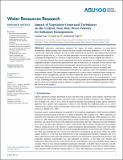| dc.contributor.author | Tang, Caihong | |
| dc.contributor.author | Lei, Jiarui | |
| dc.contributor.author | Nepf, Heidi | |
| dc.date.accessioned | 2020-06-11T17:51:51Z | |
| dc.date.available | 2020-06-11T17:51:51Z | |
| dc.date.issued | 2019-07 | |
| dc.date.submitted | 2019-06 | |
| dc.identifier.issn | 0043-1397 | |
| dc.identifier.issn | 1944-7973 | |
| dc.identifier.uri | https://hdl.handle.net/1721.1/125766 | |
| dc.description.abstract | Laboratory experiments examined the impact of model vegetation on wave-driven resuspension. Model canopies were constructed from cylinders with three diameters (d = 0.32, 0.64, and 1.26 cm) and 12 densities (cylinders/m2) up to a solid volume fraction (ϕ) of 10%. The sediment bed consisted of spherical grains with d50 = 85 μm. For each experiment, the wave velocity was gradually adjusted by increasing the amplitude of 2-s waves in a stepwise fashion. A Nortek Vectrino sampled the velocity at z = 1.3 cm above the bed. The critical wave orbital velocity for resuspension was inferred from records of suspended sediment concentration (measured with optical backscatter) as a function of wave velocity. The critical wave velocity decreased with increasing solid volume fraction. The reduction in critical wave velocity was linked to stem-generated turbulence, which, for the same wave velocity, increased with increasing solid volume fraction. The measured turbulence was consistent with a wave-modified version of a stem-turbulence model. The measurements suggested that a critical value of turbulent kinetic energy was needed to initiate resuspension, and this was used to define the critical wave velocity as a function of solid volume fraction. The model predicted the measured critical wave velocity for stem diameters d = 0.64 to 2 cm. Combining the critical wave velocity with an existing model for wave damping defined the meadow size for which wave damping would be sufficient to suppress wave-induced sediment suspension within the interior of the meadow. | en_US |
| dc.description.sponsorship | National Science Foundation (Grant 1659923) | en_US |
| dc.language.iso | en | |
| dc.publisher | American Geophysical Union (AGU) | en_US |
| dc.relation.isversionof | http://dx.doi.org/10.1029/2018wr024335 | en_US |
| dc.rights | Article is made available in accordance with the publisher's policy and may be subject to US copyright law. Please refer to the publisher's site for terms of use. | en_US |
| dc.source | Other repository | en_US |
| dc.title | Impact of Vegetation‐Generated Turbulence on the Critical, Near‐Bed, Wave‐Velocity for Sediment Resuspension | en_US |
| dc.type | Article | en_US |
| dc.identifier.citation | Tang, Caihong et al. "Impact of Vegetation‐Generated Turbulence on the Critical, Near‐Bed, Wave‐Velocity for Sediment Resuspension." Water Resources Research 55, 7 (July 2019): 5904-5917 © 2019 American Geophysical Union | en_US |
| dc.contributor.department | Massachusetts Institute of Technology. Department of Civil and Environmental Engineering | en_US |
| dc.relation.journal | Water Resources Research | en_US |
| dc.eprint.version | Final published version | en_US |
| dc.type.uri | http://purl.org/eprint/type/JournalArticle | en_US |
| eprint.status | http://purl.org/eprint/status/PeerReviewed | en_US |
| dc.date.updated | 2020-05-29T17:23:01Z | |
| dspace.date.submission | 2020-05-29T17:23:04Z | |
| mit.journal.volume | 55 | en_US |
| mit.journal.issue | 7 | en_US |
| mit.license | PUBLISHER_POLICY | |
| mit.metadata.status | Complete | |
